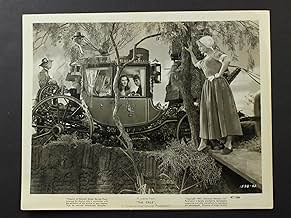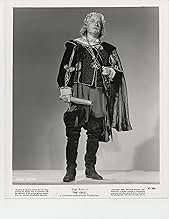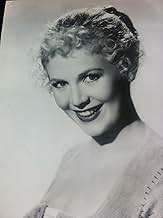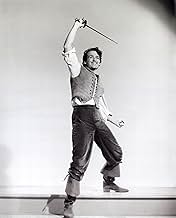Charles II, the King of England, finds himself in exile in Holland, where he falls in love with a beautiful farm-girl.Charles II, the King of England, finds himself in exile in Holland, where he falls in love with a beautiful farm-girl.Charles II, the King of England, finds himself in exile in Holland, where he falls in love with a beautiful farm-girl.
- Director
- Writers
- Stars
Paula Corday
- Katie
- (as Paule Croset)
Milton Owen
- Wilcox
- (as Milton A. Owen)
Ben Wright
- Milbanke
- (as Ben H. Wright)
Ramsay Hill
- Cavalier Officer
- (as C.S. Ramsey-Hill)
Gordon B. Clarke
- Cavalier Guard
- (as Gordon Clark)
- Director
- Writers
- All cast & crew
- Production, box office & more at IMDbPro
Featured reviews
I remember seeing the preview of THE EXILE when I was 9 years old, but never actually saw the film till last night. Reminded of this rare and all-but-forgotten picture via this website, I sought it out on the internet and purchased it for a modest price. No disappointment. A romantic adventure film set in 1660 combines real history with highly entertaining story. Douglas Fairbanks Jr. was a great leading man and he plays this role with ease and vigor. The re-creation of the era was perfect and the film has not a trace of today's annoying Attention Deficit Disorder editing. They didn't make any good movies in 2005, as evidenced by the trashy 5 lefty-spin pictures nominated as Best Picture. If you want to see a classic, don't give up on it. Seek it out and with tenacity you can find it and see it. I've only failed once, but still looking for that rarity.
Maria Montez plays a French Countess in this film and headlines the show. She's barely in the film, for goodness sake! Her role could have been completely written out - it has no relevance to the story whatsoever. She must have been very important. Can someone explain?
The story is set in Holland during the exile of England's King Charles II in 1660. Douglas Fairbanks Jr. plays the king and spends the film wooing farm girl Rita Corday (Katie). He, of course, is undercover. An interesting sub-plot is introduced when Robert Coote shows up at the farm claiming to be King Charles II and demanding food and lodgings. Cue humour. Unfortunately, there is too much humour in this film - it exists in nearly every scene which is not what I was wanting. I hoped for some actual historical fact so if you expect any truth you will be disappointed. It's basically a love story with some sword fighting. It could be set anywhere. However, I am glad that the Cavaliers won. I am a Cavalier as defined by my boys school changing-room etiquette. You showed your willy and that put you in either the Roundhead or Cavalier camp. We were only 5 years old and there were no teachers involved!
The story is set in Holland during the exile of England's King Charles II in 1660. Douglas Fairbanks Jr. plays the king and spends the film wooing farm girl Rita Corday (Katie). He, of course, is undercover. An interesting sub-plot is introduced when Robert Coote shows up at the farm claiming to be King Charles II and demanding food and lodgings. Cue humour. Unfortunately, there is too much humour in this film - it exists in nearly every scene which is not what I was wanting. I hoped for some actual historical fact so if you expect any truth you will be disappointed. It's basically a love story with some sword fighting. It could be set anywhere. However, I am glad that the Cavaliers won. I am a Cavalier as defined by my boys school changing-room etiquette. You showed your willy and that put you in either the Roundhead or Cavalier camp. We were only 5 years old and there were no teachers involved!
Max Opuls does a good job of directing, Douglas Fairbanks Jr is fun to watch, and Henry Daniell is absolutely superb as the ruthless villain, but the ending is much too serious and monarchic, especially in view of the fact that Charles II was ready to help out in the kitchen and be a farmhand. I could see this film being made prior to WWII with all the bowing to the British crown and empire, but by 1947 it seems out of sync with its time.
Wonderful photography, great duel between DF Jr and Daniell. Some clever dialogue, especially from DF Jr.
Above average, worth watching despite the drawbacks pointed out above which, of course, might even be positives from the standpoint of someone of more aristocratic leanings.
Wonderful photography, great duel between DF Jr and Daniell. Some clever dialogue, especially from DF Jr.
Above average, worth watching despite the drawbacks pointed out above which, of course, might even be positives from the standpoint of someone of more aristocratic leanings.
The costuming for this film must bring a smile to the face of anyone familiar with fashions of the 17th century. The film's action occurs in 1660, but Fairbanks and his colleagues wear jerkins fitted to the waist, stylish about 1620-1630, but apparently considered more dashing than the loose smocks and petticoat breeches of 1660. Then Maria Montez arrives, wearing a gown clearly from the 1880 Wild West costume rack in the Wardrobe Department. To atone, her second frock is only a century out of kilter, something from about 1750.
I found the sound-stage exteriors very claustrophobic and phony, and I noted only 3 instances when I felt the "Ophüls touch," for example when the shutter blew open and closed, alternately revealing and concealing the lovers as they approach their first kiss. I'm also puzzled why Max Ophüls is listed as "Opuls" in the credits, but perhaps that is a phonetic rendering to eliminate the umlaut?
I found the sound-stage exteriors very claustrophobic and phony, and I noted only 3 instances when I felt the "Ophüls touch," for example when the shutter blew open and closed, alternately revealing and concealing the lovers as they approach their first kiss. I'm also puzzled why Max Ophüls is listed as "Opuls" in the credits, but perhaps that is a phonetic rendering to eliminate the umlaut?
Douglas Fairbanks Jr starred as Charles II, the eponymous role in this swashbuckler and produced as well. It says much for his modesty, that he appears last in the end credits though he is undoubtedly the star. As a swordsman and acrobat he turns in a performance that his father would have been proud of and also brings wit and charm to the table. His romantic relationship with a Dutch girl, played by Paule Croset (later to become more famous under the name of Rita Corday), however is just ok. Maria Montez is much more fun as a coquettish countess and seems to have more chemistry with Fairbanks. Director Max Ophuls presides over a beautifully shot film with impressive mise en Scene and there is superb editing when we cross cut several times between the Netherlands where Fairbanks and Croset work and play, and England where the machinations of the puritans to catch or kill the king are brewing. The music in Holland is playful whilst being militaristic and sinister in England, during this sequence; stirring stuff! And speaking of the Puritans, Henry Daniell is perfectly and icily cast as a Roundhead Colonel. He arrives in The Netherlands like a black hatted western gun slinger on the trail of our hero and is compelling in his fanaticism. It feels like he and Fairbanks are fated to meet, by destiny and only one will survive. The duel between the two backs this up more than somewhat and Daniell steals the film in the process. In the supporting cast, Robert Coote is a hoot as an impoverished actor, dishonestly masquerading as Charles II himself in order to obtain free food and lodging and Nigel Bruce plays it straight to good effect as the real king's right hand man and confidant, impressing us with his raspy voice of experience and touching us with his devotion to his monarch and friend.
Did you know
- TriviaBecause of contractual requirements, Maria Montez receives star billing even though her role only demands she be on screen for about ten minutes, 40 minutes into the film, after which she is never seen again. Although the film was not produced by Universal, it was released by that studio and concluded Montez's contract with the studio.
- Alternate versionsDirector Max Ophuls's original ending was changed prior to the American release. In the original ending, there is an unbroken shot that starts with Nigel Bruce's character waiting outside the door and goes on to follow Douglas Fairbanks Jr. (in his regal garb) as he descends the stairs and walks out into the crowd. Katie (Rita Corday) prays and leaves her room. Two men enter the now-empty inn and discuss the placement of a commemorative plaque for the site. As they go over the wording for the plaque (about Charles II's loyal supporters, etc.), they notice Katie exiting in the background and dismiss her as unimportant. As they continue reading, the screen dissolves to a shot of the plaque (seen earlier in the film), closing in on the engraved image of Charles II's head in profile at the bottom. (In the American release ending, a quick shot of Katie leaving her room breaks up the shot of Fairbanks descending the stairs. After the king exits, the film cuts to the plaque and the engraved image.) The original ending may have been seen on international prints of the film. Turner Classic Movies has, on occasion, shown the alternate ending as a bonus after airing the American version of the film.
- ConnectionsReferenced in The Flop House: The Flop House: Episode 98 - In Time (2012)
- How long is The Exile?Powered by Alexa
Details
- Runtime1 hour 35 minutes
- Aspect ratio
- 1.37 : 1
Contribute to this page
Suggest an edit or add missing content





































